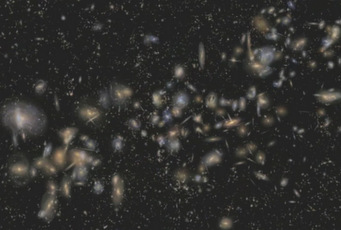A mind-boggling 1.5 million galaxies trace out the filaments, clusters, and voids in Sloan Digital Sky Survey's new 3D map of the universe.

A still of the Sloan Digital Sky Survey's new 3D map of the universe.
M.A. Arag??n (Johns Hopkins Univ.), M. SubbaRao (Adler Planetarium), A. Szalay (Johns Hopkins Univ.), Y. Yao (Lawrence Berkeley National Laboratory, NERSC), and the SDSS-III Collaboration
When I was in graduate school not so very long ago, I studied X-rays and visible light radiated by quasars, brilliant beacons powered by supermassive black holes in distant galaxies. At the time, I used the largest data set available: almost 100,000 quasars observed by the Sloan Digital Sky Survey (SDSS). This robotic telescope has surveyed the night sky since 2001, taking images and spectra of countless objects night after night. The riches were (and are) freely available to anyone, including teachers (complete with suggested lesson plans), Joe and Jane Public, and graduate students like I was.
So you'll have to forgive me for growing a little nostalgic when I learned of the latest data set released by the SDSS last week, one that dwarfs what I had available only a few short years ago.
In 2005 I analyzed quasar spectra from Data Release 5. The massive data set contained images and spectra of 675,000 galaxies, 90,500 quasars, and 155,000 stars — numbers that boggle the imagination. Now, Data Release 9 has more than doubled the number of galaxies and quasars. And with two surveys (SEGUE-2 and APOGEE) dedicated to observing stars in the Milky Way, the number of stars has more than quadrupled. Astronomers can now sift through data stored in tens of terabytes.
It's not easy to imagine 1.5 million galaxies. But let's try. Take a tour through SDSS's new 3D map of the universe:
SDSS measures the positions of each galaxy by mapping out its position on the sky and then adding information from its spectrum to give the third dimension. The spectra show a signature of the expanding universe that reveals the galaxy's distance from Earth. Every galaxy is represented by a template in the video that matches the actual shape (spiral or elliptical) of the real galaxy.
As the camera zooms through the universe at impossible speeds, the filaments connecting galaxy clusters and the voids in between become obvious. The primary goal of making this map is to understand how that structure came to be. We're still a long way from understanding the influence of dark matter and dark energy on our universe, so here's to the work of future researchers, especially the grad students!
 4
4
Comments
Mike W. Herberich
August 14, 2012 at 10:36 am
It is absolutely marvelous! Although one may picture (note: meaning of the word!) in one's head what it may look like -from the data- ...: seeing is believing! No generation before has been able to behold such a sight! Amazing, graceful and stunning. Thank you for the link, Dr. Young.
You must be logged in to post a comment.
Bruce
August 14, 2012 at 3:39 pm
I agree completely Mike. What I like the most about this 3D map is that it’s not just a mere simulation of what the universe might be like; it’s based on actual data, where these galaxies actually are in the three spatial dimensions. Thus the map’s helping us view the universe as it actually is, and it can serve as an excellent teaching aid. When showing this to others we should not fail to mention that each galaxy contains an average of about 100 billion stars, and that what we’re seeing in the map isn’t the whole universe, as might be implied by the title, but really only a very small part of the universe. Even if the map includes all 1.5 million galaxies in the latest Sloan Survey it still only includes the nearest of the 100 BILLION galaxies estimated to exist inside our event horizon. Just trying to keep things in proper perspective.
You must be logged in to post a comment.
Durval Menezes
August 17, 2012 at 3:29 pm
It will be nice when this dataset is available for Partiview...
You must be logged in to post a comment.
The CHeesy
December 27, 2013 at 11:36 pm
The Cheesy Animation- 3d Visualization offering services like 3D Architectural Rendering, 3D Architectural, 3D Rendering, 3D Architectural Design, 3D Architectural Walkthrough, 3D Architectural Company.
Visit Us:- http://www.thecheesyanimation.com/3D-Architectural-Rendering.html
You must be logged in to post a comment.
You must be logged in to post a comment.